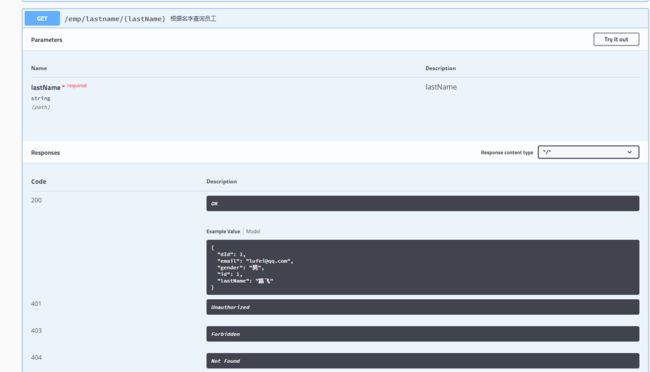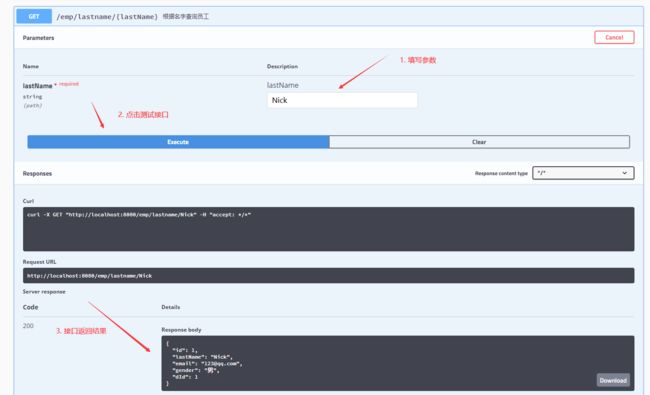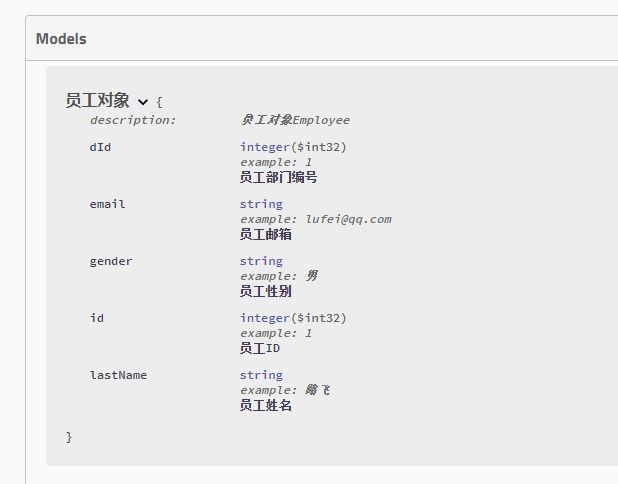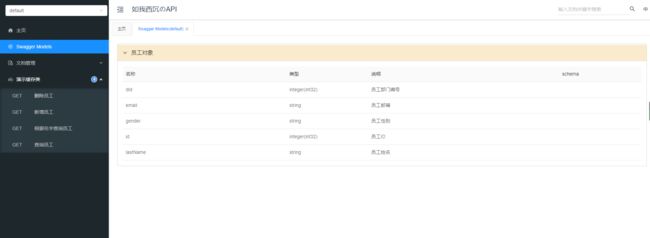Spring学习笔记(三十三)——SpringBoot集成Swagger
目录
- Swagger相关介绍
- Swagger的配置和使用
-
- 1. 添加相关的依赖坐标
- 2. 在配置文件中配置Swagger
- 3. 添加swagger配置类
- 4. 配置Modler对象
- 5. 编写controller层接口
- 6. 测试效果
- Swagger常用注解
-
- 1. 用于controller类
- 2. 用于接口方法上(对接口方法的说明)
- 3. 用于Model实体类
- 4. 用于接口方法上(对要提供的参数说明)
- 5. 用于类或者方法上
- 集成Swagger-Bootstrap-UI
Swagger相关介绍
1. Swagger是什么
Swagger 是一个规范且完整的框架,用于生成、描述、调用和可视化 RESTful 风格的 Web 服务,可以让你更好的书写API文档规范且完整。
2. 为什么要使用Swagger
在实际的开发中,前后端多多少少都被接口文档的编写的调用折磨过。前端经常抱怨后端给的接口文档与实际情况不一致;后端又觉得编写及维护接口文档会耗费不少精力,经常来不及更新。其实无论是前端调用后端,还是后端调用后端,都期望有一个好的接口文档。
3. Swagger 的优势
- 支持 API 自动生成同步的在线文档:使用 Swagger 后可以直接通过代码生成文档,不再需要自己手动编写接口文档了,对程序员来说非常方便,可以节约写文档的时间去学习新技术。
- 提供 Web 页面在线测试 API:光有文档还不够,Swagger 生成的文档还支持在线测试。参数和格式都定好了,直接在界面上输入参数对应的值即可在线测试接口。
Swagger的配置和使用
1. 添加相关的依赖坐标
<dependency>
<groupId>io.springfoxgroupId>
<artifactId>springfox-swagger2artifactId>
<version>2.9.2version>
dependency>
<dependency>
<groupId>io.springfoxgroupId>
<artifactId>springfox-swagger-uiartifactId>
<version>2.9.2version>
dependency>
<dependency>
<groupId>com.github.xiaoymingroupId>
<artifactId>swagger-bootstrap-uiartifactId>
<version>1.6version>
dependency>
2. 在配置文件中配置Swagger
# 配置swagger
swagger.basePackage:cn.kt.springboot_cache
swagger.title:如我西沉のAPI
swagger.description:干嘛这么想不开,要在脸上贴个输字。
swagger.version:V1.0
3. 添加swagger配置类
package cn.kt.springboot_cache.config;
/**
* Created by tao.
* Date: 2021/10/12 9:21
* 描述:
*/
import org.springframework.beans.factory.annotation.Value;
import org.springframework.context.annotation.Bean;
import org.springframework.context.annotation.Configuration;
import springfox.documentation.builders.ApiInfoBuilder;
import springfox.documentation.builders.PathSelectors;
import springfox.documentation.builders.RequestHandlerSelectors;
import springfox.documentation.service.ApiInfo;
import springfox.documentation.service.Contact;
import springfox.documentation.spi.DocumentationType;
import springfox.documentation.spring.web.plugins.Docket;
import springfox.documentation.swagger2.annotations.EnableSwagger2;
/**
* Swagger配置类.
*/
// Swagger的开关,表示已经启用Swagger
@EnableSwagger2
@Configuration
public class SwaggerConfiguration {
// controller接口所在的包
@Value("${swagger.basePackage}")
private String basePackage;
// 当前文档的标题
@Value("${swagger.title}")
private String title;
// 当前文档的详细描述
@Value("${swagger.description}")
private String description;
// 当前文档的版本
@Value("${swagger.version}")
private String version;
@Bean
public Docket createRestApi() {
return new Docket(DocumentationType.SWAGGER_2)
.apiInfo(apiInfo())
.select()
.apis(RequestHandlerSelectors.basePackage(basePackage))
.paths(PathSelectors.any())
.build();
}
private ApiInfo apiInfo() {
return new ApiInfoBuilder()
.title(title)
.description(description)
.version(version)
// 参数分别是:作者昵称、作者网站、作者邮箱
.contact(new Contact("如我西沉", "http://qkongtao.cn/", "******@qq.com"))
.build();
}
}
4. 配置Modler对象
不进行配置也可以,Swagger会根据对象名进行自动生成
package cn.kt.springboot_cache.domain;
import io.swagger.annotations.ApiModel;
import io.swagger.annotations.ApiModelProperty;
import java.io.Serializable;
@ApiModel(value="员工对象",description="员工对象Employee")
public class Employee implements Serializable {
@ApiModelProperty(value="员工ID",name="id",example="1")
private Integer id;
@ApiModelProperty(value="员工姓名",name="lastName",example="路飞")
private String lastName;
@ApiModelProperty(value="员工邮箱",name="email",example="[email protected]")
private String email;
@ApiModelProperty(value="员工性别",name="gender",example="男")
private String gender;
@ApiModelProperty(value="员工部门编号",name="dId",example="1")
private Integer dId;
/* 省略get、set、构造方法 */
}
5. 编写controller层接口
不进行配置也可以,Swagger会根据方法名进行自动生成,但是接口建议配置,添加自己的接口文档说明。
本次测试使用上一篇缓存项目的接口
package cn.kt.springboot_cache.controller;
import cn.kt.springboot_cache.domain.Employee;
import cn.kt.springboot_cache.service.EmployeeService;
import io.swagger.annotations.Api;
import io.swagger.annotations.ApiOperation;
import org.springframework.beans.factory.annotation.Autowired;
import org.springframework.web.bind.annotation.GetMapping;
import org.springframework.web.bind.annotation.PathVariable;
import org.springframework.web.bind.annotation.RestController;
/**
* @author tao
* @date 2021-09-20 10:26
* 概要:
*/
@RestController
@Api(tags = "演示缓存类", description = "EmployeeController相关描述")
public class EmployeeController {
@Autowired
private EmployeeService employeeService;
@GetMapping("/emp/{id}")
@ApiOperation(value = "查询员工", notes = "方法的注意事项和备注", nickname = "tao", consumes = "text/html")
public Employee getEmployee(@PathVariable("id") Integer id) {
Employee emp = employeeService.getEmp(id);
return emp;
}
@GetMapping("/emp")
@ApiOperation("新增员工")
public Employee update(Employee employee) {
Employee emp = employeeService.updateEmp(employee);
return emp;
}
@GetMapping("/delemp")
@ApiOperation("删除员工")
public String deleteEmp(Integer id) {
employeeService.deleteEmp(id);
return "success";
}
@GetMapping("/emp/lastname/{lastName}")
@ApiOperation("根据名字查询员工")
public Employee getEmpByLastName(@PathVariable("lastName") String lastName) {
return employeeService.getEmpByLastName(lastName);
}
}
6. 测试效果
访问地址:项目链接/swagger-ui.html
默认项目的地址是 http://localhost:8080/swagger-ui.html
Swagger常用注解
1. 用于controller类
@Api():用于类;表示标识这个类是swagger的资源
参数:
tags–表示说明 (tags如果有多个值,会生成多个list)
value–也是说明,可以使用tags替代
description–接口的描述
使用方法:
@RestController
@Api(tags = "演示缓存类", description = "EmployeeController相关描述")
public class EmployeeController {
}
2. 用于接口方法上(对接口方法的说明)
@ApiOperation() 用于方法;表示一个http请求的操作
value用于方法描述
notes用于提示内容
tags可以重新分组(视情况而用)
@ApiParam() 用于方法中要接收的参数,字段说明;表示对参数的添加元数据(说明或是否必填等)
name–参数名
value–参数说明
required–是否必填
使用方法:
@GetMapping("/emp/lastname/{lastName}")
@ApiOperation("根据名字查询员工")
public Employee getEmpByLastName(@PathVariable("lastName") @ApiParam(name = "lastName", value = "用户名", required = true) String lastName) {
return employeeService.getEmpByLastName(lastName);
}
3. 用于Model实体类
@ApiModel()用于类 ;表示对类进行说明,用于参数用实体类接收
value–表示对象名
description–描述
都可省略
@ApiModelProperty()用于方法,字段; 表示对model属性的说明或者数据操作更改
value–字段说明
name–重写属性名字
dataType–重写属性类型
required–是否必填
example–举例说明
hidden–隐藏
使用方法:
@ApiModel(value="员工对象",description="员工对象Employee")
public class Employee implements Serializable {
@ApiModelProperty(value="员工ID",name="id",example="1")
private Integer id;
@ApiModelProperty(value="员工姓名",name="lastName",example="路飞")
private String lastName;
@ApiModelProperty(value="员工邮箱",name="email",example="[email protected]")
private String email;
@ApiModelProperty(value="员工性别",name="gender",example="男")
private String gender;
@ApiModelProperty(value="员工部门编号",name="dId",example="1")
private Integer dId;
}
4. 用于接口方法上(对要提供的参数说明)
@ApiImplicitParams() 用于方法,包含多个 @ApiImplicitParam
@ApiImplicitParam() 用于方法
表示单独的请求参数
name–参数ming
value–参数说明
dataType–数据类型
paramType–参数类型
example–举例说明
使用方法:
@GetMapping("/emp")
@ApiOperation("新增员工")
@ApiImplicitParams({
@ApiImplicitParam(name = "id", value = "用户id", dataType = "long", paramType = "query", example = "索隆"),
@ApiImplicitParam(name = "lastName", value = "用户名", dataType = "string", paramType = "query", example = "索隆"),
@ApiImplicitParam(name = "email", value = "用户邮箱", dataType = "string", paramType = "query", example = "[email protected]")})
public Employee update(Employee employee) {
Employee emp = employeeService.updateEmp(employee);
return emp;
}
5. 用于类或者方法上
@ApiIgnore()用于类或者方法上,可以不被swagger显示在页面上
比较简单, 这里不做举例
小结:Swagger提供的注解功能还是很丰富的,但在具体开发中如果全部都要去使用还是挺麻烦的,所以怎么使用,如何使用,还是看开发实际情况吧。
集成Swagger-Bootstrap-UI
SpringBoot集成Swagger后,除了可以时候原始风格的API接口界面,还可以集成其他风格的界面:如页面更清爽的Swagger-Bootstrap-UI和knife4j-spring-ui。
该开源项目GitHub地址:https://github.com/xiaoymin/Swagger-Bootstrap-UI
该开源项目中文文档地址:https://doc.xiaominfo.com/
配置好Swagger后,引入依赖即集成成功
老版本引用
<dependency>
<groupId>com.github.xiaoymingroupId>
<artifactId>swagger-bootstrap-uiartifactId>
<version>1.9.6version>
dependency>
新版本引用
<dependency>
<groupId>com.github.xiaoymingroupId>
<artifactId>knife4j-spring-uiartifactId>
<version>2.0.9version>
dependency>
效果展示
访问新UI的的链接:http://localhost:8080/doc.html











